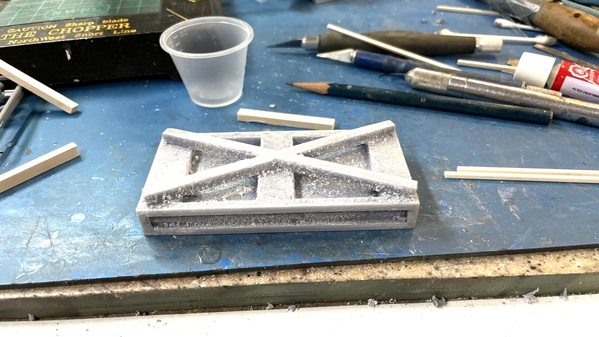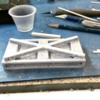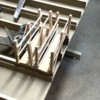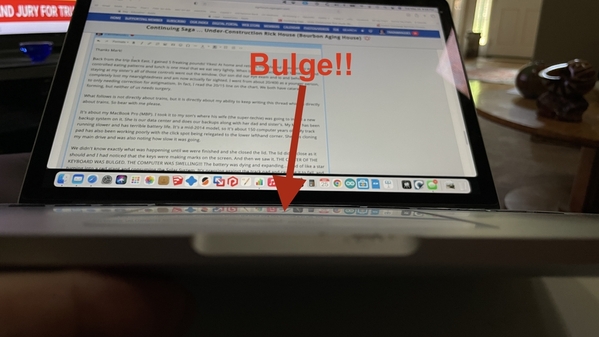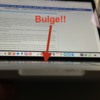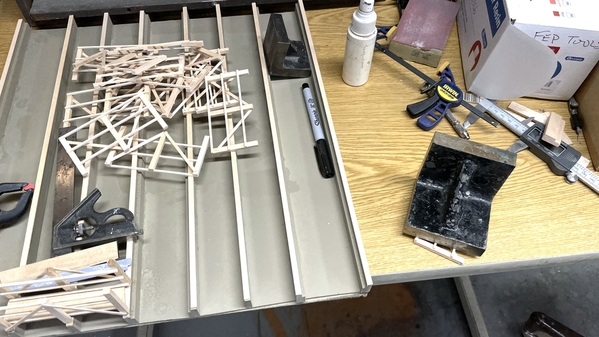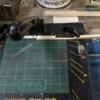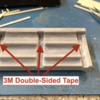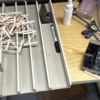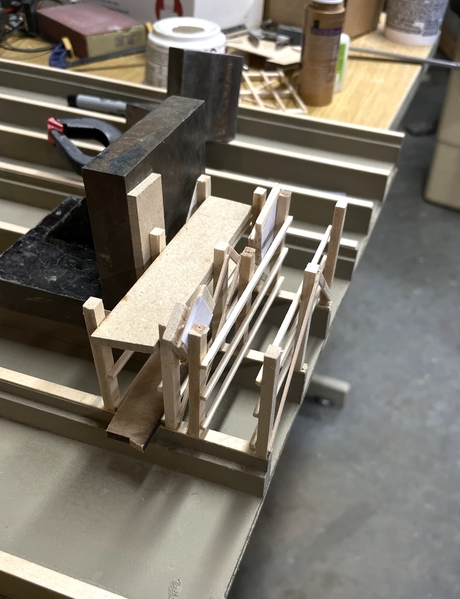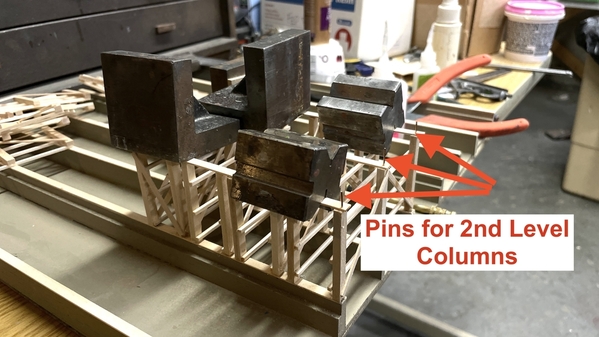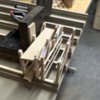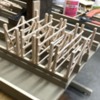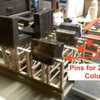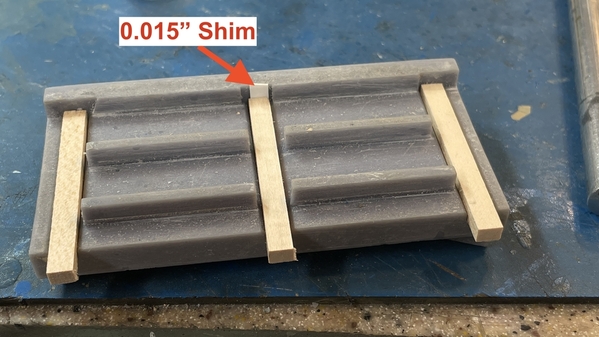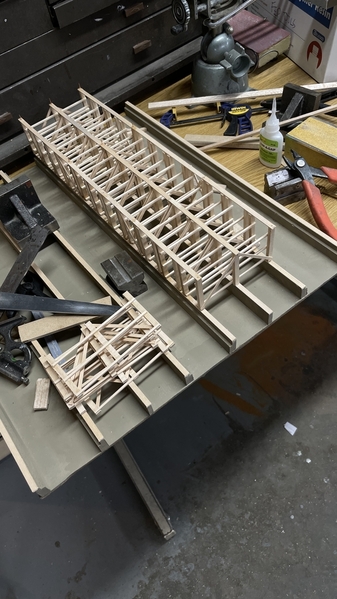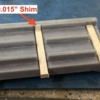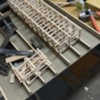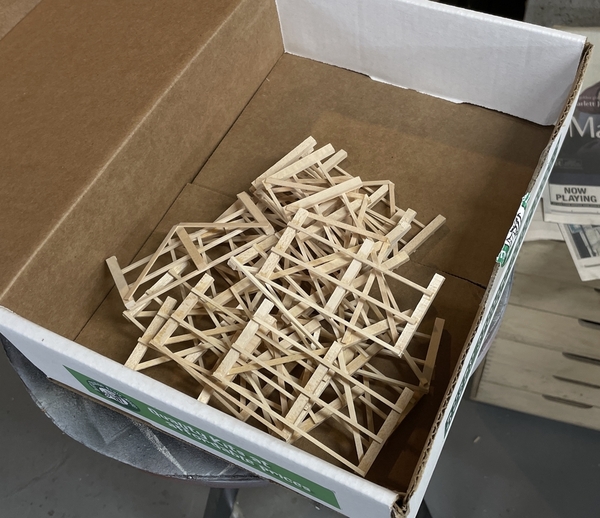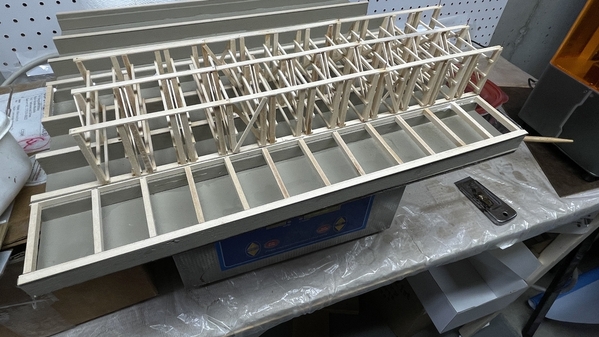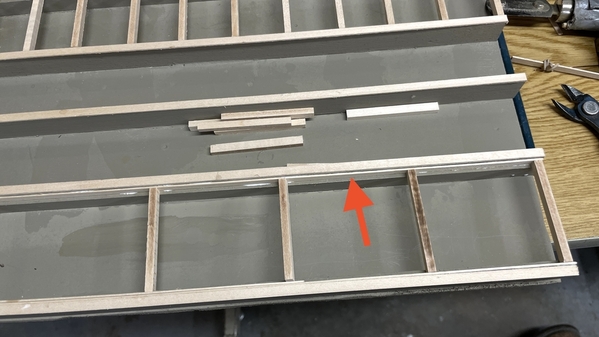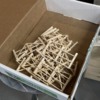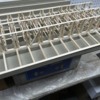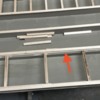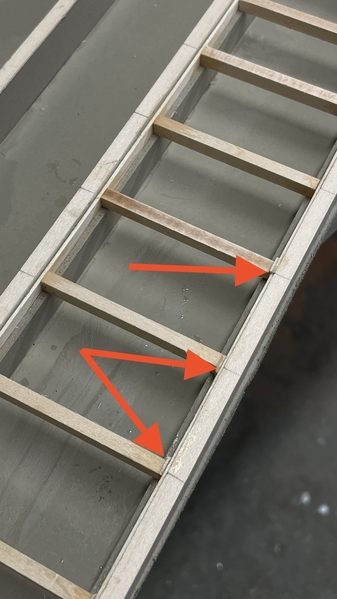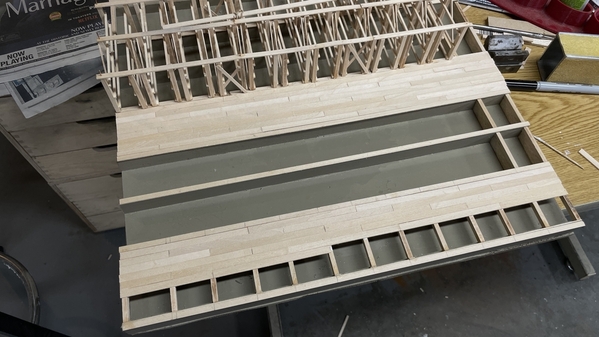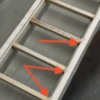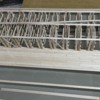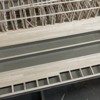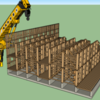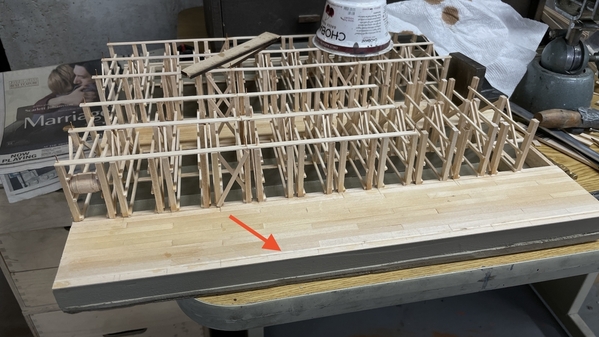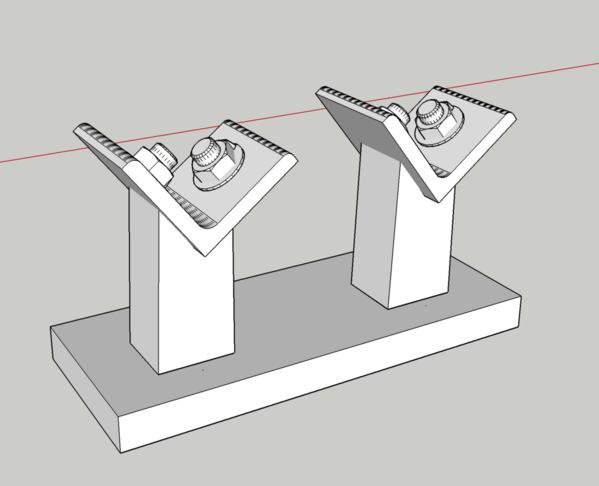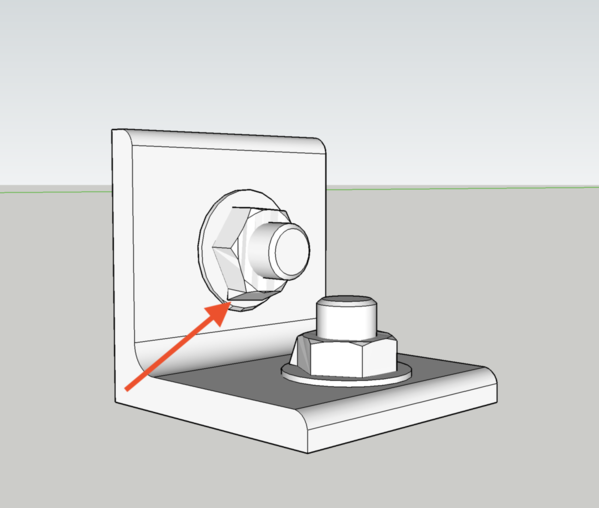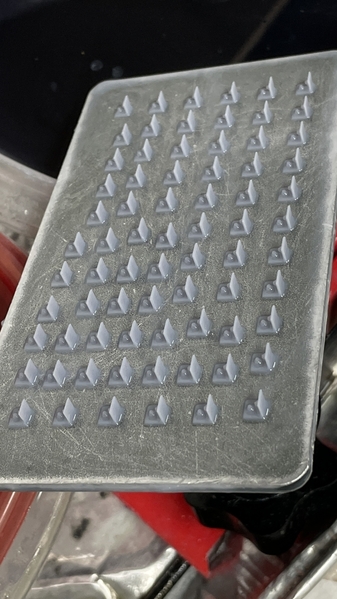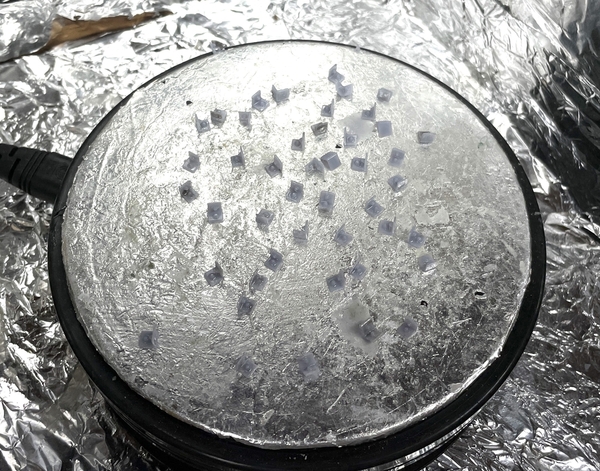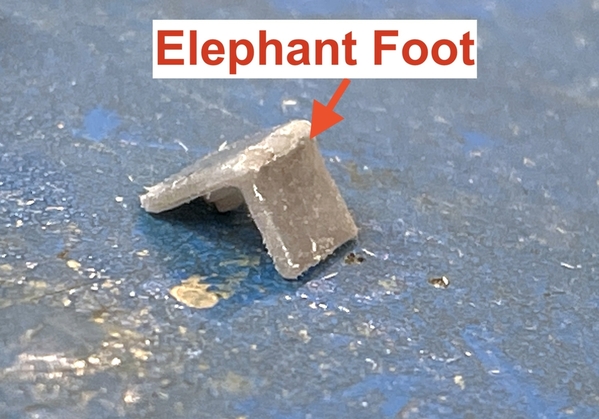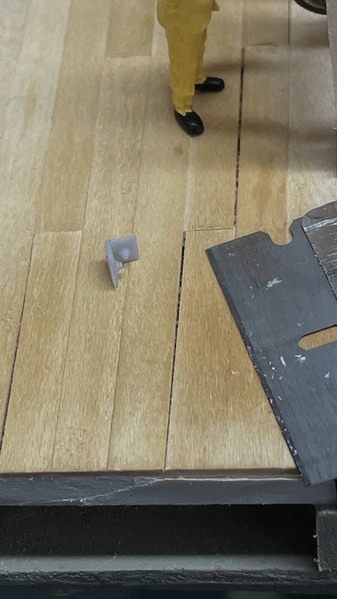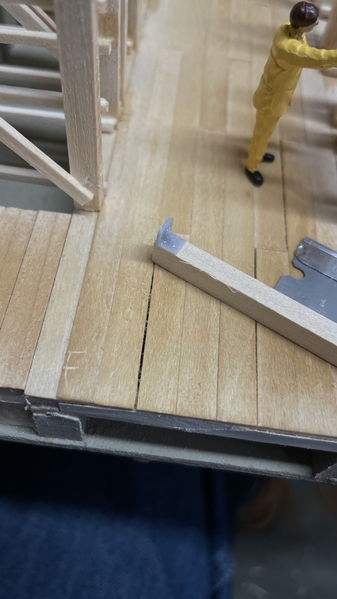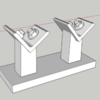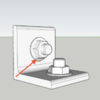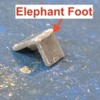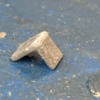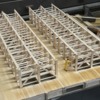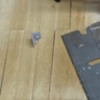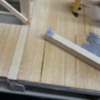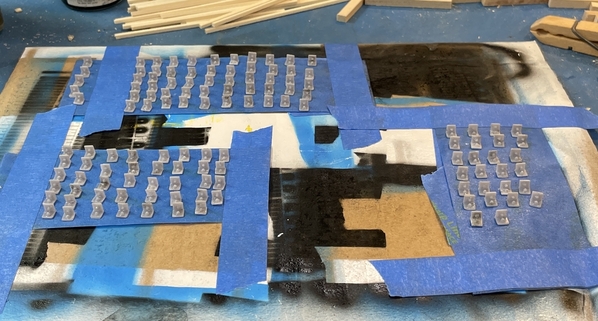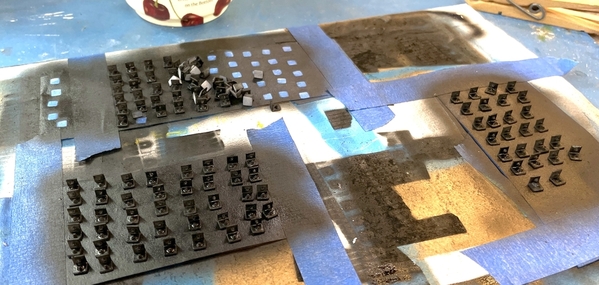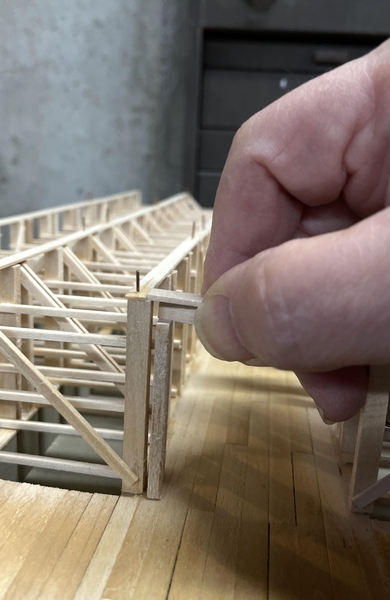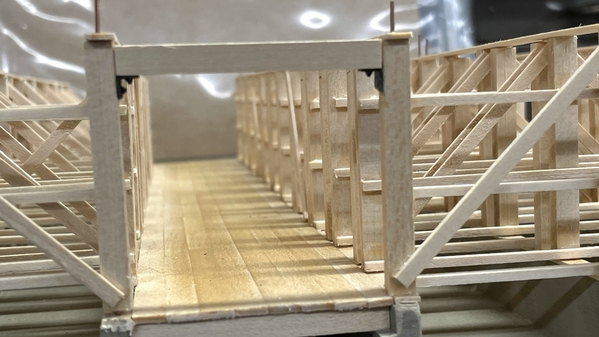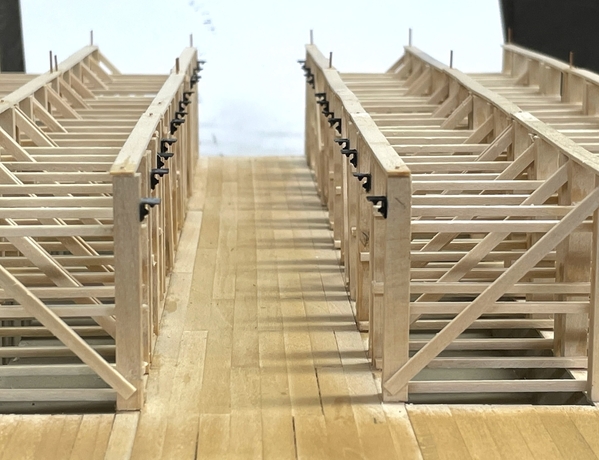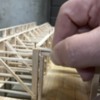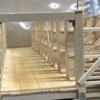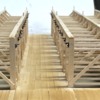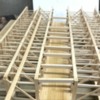Good advice, Pat!
Yup! It's tedious, but my wife tells me to never complain about my hobby. "It's your hobby… nobody's forcing you to do it." She's not sympathetic to any of my workshop complaints. I did redesign the rick build jig to refine it and slightly change the spacing. I measured the "as built" sole plate spacing and it was about 1/32 or so narrower than the fixture. I also opened up the column slots a bit since they actually mic out to about .200" instead of .188". Lastly I added a slight chamfer on the slots to make it easier to insert the columns into the slots. Which reminds me, there's one more change. The current jig ends right at the column ends so I needed to insert a blade to start lifting them to remove them. I'm going to shorten the jig's bottom edge a bit so the column sticks out a bit to facilitate getting them out without too much pressure. I just made that change and saved it to the thumb drive. I'll print it on Monday.
That version didn't work. The slots were still too tight and the thing warped. When I tried to straighten it more it fractured in half. Back to the drawing board. I'll print it tomorrow, and eventually we'll get it right.
The 3rd time was a charm. I got a perfect print, not warping, and the columns drop into their slots easily and as are easy to remove. The tricky part was working with full size, real world dimensions in SU and then shrinking everything by 1:48 to make the print files. As I've note before, SU works best when objects are big… bigger is better. I enlarged the slots so they were about .005" wider than the widest measured column. I glued a few rick sets together to test it and it works perfectly. I can removed the glued up rick without stressing the joints.
The front looks like this. The slots look bigger because I added a chamfer on the edges to make it easy to insert the columns. Notice also, I made the jig shorter than the columns so I can easily remove them.
The back has a big reinforcing cross-brass that helped keep it from warping. The rough finished is what it looks like when you peel off a forest of supports and don't need to worry about surface finish. This is just a tool, not a finished part. The hollowed out portions were there to reduce the resin amount.
Here's four ricks, but only the first bay is glued in place. I also corrected the length problem so the ricks now match the sole plates. I asked Nick Morris how the columns are fastened to the sole plates. If you remember, Nick is the Buzick engineer helping me with this project. He said, they're just nailed… like normal house construction. I also asked Nick about the elevator shaft and stair wells. He said they're added to the perimeter so I can still do that if I so desire AND if I have the room. Making the ricks won't take too long. It only takes a few minutes to make each one. That, of course, is after I have all the stock cut. I had to change my spacing jig. My first jig which I used for the early attempts, had the barrel rails starting higher on the columns so my jig had to slip underneath and contacted the columns proper. I realized this error in my rick jig redesign and now the first barrel rail is almost touching the bottom so my spacing jig would have been too wide. I cut it down by two rail thicknesses. Keeping all this square is going to be quite a challenge.
Attachments
It looks like you are well on your way now!
Thanks Mark!
Back from the trip back East. I gained 5 freaking pounds! Yikes! At home and retired, my wife and I have pretty well controlled eating patterns and lunch is one meal that we eat very lightly. When traveling back the old homestead and staying at my sister's all of those controls went out the window. Our son did our eye exam and lo and behold, I've completely lost my nearsightedness and am now actually far sighted. I went from about 20/400 as a younger person, to only needing correction for astigmatism. In fact, I read the 20/15 line on the chart. We both have cataracts forming, but neither of us needs surgery.
What follows is not directly about trains, but it is directly about my ability to keep writing this thread which is directly about trains. So bear with me please.
It's about my MacBook Pro (MBP). I took it to my son's where his wife (the super-techie) was going to install a new backup system on it. She is our data center and does our backups along with her dad and sister's. My MBP has been running slower and has terrible battery life. It's a mid-2014 model, so it's about 150 computer years old. My track pad has also been working poorly with the click spot being relegated to the lower lefthand corner. She was cloning my main drive and was also noting how slow it was going.
We didn't know exactly what was happening until we were finished and she closed the lid. The lid didn't close as it should and I had noticed that the keys were making marks on the screen. And then we saw it. THE CENTER OF THE KEYBOARD WAS BULGED. THE COMPUTER WAS SWELLING!!! The battery was dying and expanding… kind of like a star turning into a red giant and consuming the Solar System. It's pressing against the track pad and causing it to fail, and it's probably affecting everything else.
This image shows the convex curvature on the keyboard looking at it edge-on.
In other words, the computer is dying. We thought it was an isolated, rare occurrence, but when I went on Apple to see about trading it in, one of the questions you must answer to determine its trade-in value was "Is the track pad working properly AND/OR is the computer swelling?" In other words, it's so common that it's one of Apple's questions about the computer's condition. And the answer I got from Apple after I finished was, "We will help you recycle it."Therefore, it is now junk.
So now I'm in the market for a new MacBook Pro. My daughter in law says I really need 2TB hard drive. My current computer had 512 GB. Of that 125 GB is already used by the VM Fusion partition that lets me run Windows and CorelDraw, which I use for many of my projects. I filled the rest and had to off load 200 GB on an auxiliary drive. So I'm really using over 700 GB. She also told me that Macs like to have 10 to 15% free disk space to work best. So 1TB would only had about 100 GB free space at the start. I will fill that quickly, ergo 2 TB.
A MBP with a 2TB SSD and the higher memory on the video card retails for $3,299.00. I can get the same spec at the Apple refurbished computer store for $2,799.00, a $500 difference. And I can get the refurbished one in two days whereas the new one would be in 2 weeks.
Since I started writing the post, I did further study and more interactions with daughter in law. My wife and decided to buy new instead of refurbished. I can probably make due with the 1TB SSD, and the difference between 4GB on the video card and 8GB is negligible if you're not into serious gaming or heavy video editing, of which I am not involved in either. So I can get a right-out-of-the-box MBP with 1TB and the 4GB video memory. Regardless, it's much more powerful than my 7 year-old MBP. If I get it now, before my computer actually dies (now it's only 'mostly dead'), I can transfer files from old to new via the Migration Assistant and our WiFi. That alone is a reason to move quickly. If the computer's dead, then I have to build the new one from a clone of the old one's hard drive, which to me is much more complicated. I have files that really can be archived and don't need to take up space on the new computer.
So I'm ordering it tonight and they can deliver it tomorrow with free shipping. I'm also getting Apple Care which everyone tells me is a requirement. So wish me luck on the file transfer. It's never quite as easy as they make it out to be.
Attachments
You can pick up a portable hard drive if you need more memory. I back up my MB Pro with one of those and have another for bigger files to keep the computer uncluttered. Mine is a 2015 but Apple had a recall on the batteries a couple of years ago and I had them trade it out.
Myles, that is exactly what happened with my eyes before I had the cataracts removed. It was a total flip flop, also all lights looked like starbursts before the surgery.
I have never had an Apple computer, but it sounds a lot harder to figure out what to do with it than you would think.
When I got my cateract surgery, I had a paid option to clear my astigmatism. I now only need reading glasses after 40 years of wearing glasses all the time.
Computer crash is always a traumatic event. Your lucky you didn't lose data. Good luck with the new computer.
Because my astigmatism is very regular in both eyes, my son says I'm a good candidate for the Toric lenses (astigmatism correction). That would be great to just have to wear glasses for close work. I have two flares off of lights on my good left eye, but my not-so-good right eye has has absolutely no aberrations. Neither my wife or eye need the surgery… yet.
My new MBP arrives tomorrow and since the old one is still fully functional, I will be able to move everything into it using Mac's Migration Assistant that connects through WiFi. My son in law suggested that I wait until the new M1 Chip MBPs arrive later this year (next year), and if my computer dies in the interim, just load it with a clone. That is a much riskier proposition. My son in law is a comfortable risk taker. I'm a little more reserved in that department. The M1 CPU MBPs will be more powerful, but right not, doesn't work with VM Fusion Windows emulator. No Windows = no CorelDraw. No CorelDraw = no laser cutting drawings. Parallels is another emulator that will work with the new MBP, but it's a $100 price tag and I already own VM Fusion.
So wish me luck tomorrow in transitioning all the stuff. I ordered another Western Digital auxiliary drive to make a clone just in case. I have data on my current auxiliary (also a WD HD), so I can't reformat it to make the clone. The data is all the finished model projects that I had to offload when running out of storage space. I don't want to lose that.
Later today, I will be working on the Rick House and some figures for the Bradley project.
I hope the data all moves over without incident.
Before I regale you with all the gory details, I am now writing this post on the new MacBook Pro 16". After I do the "trains" portion of the post, I'll tell about transitioning about 800,000 files into the new machine.
I produced more ricks and am getting faster in building them. It's sort of a quasi-mass-production scheme. I'm cutting the barrel rails with the power miter, and the cross braces with the Chopper. This keeps me from having to switch the setup since I don't want to have to cut hundreds at one time… BORING! Instead I cut a small batch, glue it all together and cut another batch.
With the power miter I'm gang gutting them 3 at a time. One the chopper, I'm doing two at a time. The width of my movable stop is the limiting factor.
I was having some trouble with the columns coming out of the jig TOO easily. I put some double sided tape on the bottom to stabilize them a bit. It's working.
And here's today's output. After gluing I plop that angle plate onto the rick to hold it tightly under it's fully cured.
I'm going to publish this now and pick it up later.
So if you're so inclined here's the saga of how I move the files to the new machine. I had assumed that the new machine would have the latest version of the Mac operating system, Big Sur. To use the Migration Assistant, both machines have to have the same version of the operating system, so yesterday morning I updated my old machine, let's call it Mac 1, with Big Sur Ver. 12. 4.
The new machine, Mac 2, arrived late in the afternoon, and after unpacking wanted to get right to work. When you open the screen it automatically turned on, I answered the first two dialogs, language and locality and then the window opened to migrate the files. I set up Mac 2 on our WiFi and the two computers went searching for each other and couldn't find anything. I tried a couple of times then realized something wasn't quite right. I needed to check it's version of the operating system and went to "About This Mac" and found that this "new" computer was made in 2019 and was still running OS Catalina. It was running a completely out of date operating system. I manually updated it to Big Sur. It's huge download and was taking a long time. Then it halted and said "Update couldn't be completed because it couldn't verify the OS". I tried again, and it crapped out again. Something else was wrong.
On a whim I looked to see if the version of Catalina was correct and it turned out that an update was available for it. I updated Catalina which took another half hour and then tried loading Big Sur again. Meanwhile I contacted Apple Support since I was getting worried. The Catalina update did the trick and Big Sur loaded completely. I was talking with the support tech while is was loading and we both realized it was going to take a long time, so we disconnected with a date for him to call back.
With both Macs with up-to-date OS, they both found each other and the Migration Assistant could begin. You select the files that you wish to move and let 'er rip. It took well over an hour to transfer about 800,000 files via WiFi. It was transferring at around 50 megabits/second.
When it finished I was all excited to see if A) SketchUp worked and B) if the VM Fusion Windows emulator worked. SketchUp crashed immediately on startup and did so repeatedly. And VM Fusion started, but then couldn't find Windows. No Windows = no CorelDraw. I had no idea what do about either one of these problems, but was totally bummed since they are both essential to the model work that I do. It was Twelve minutes after Midnight and I was going to bed.
Had a crumby night probably due to stress. Work up in the morning and after breakfast started up the Mac 2 to see if I could figure it out. None of my screen or file configurations were there. It was nothing like my Mac 1, but I thought that Migration Assistant would replicate the machines. An error window popped up stating, "I needed to recertify my iCloud registration" or something to that effect, so I filled in my user name and password, and POOF!! All the files appeared in their proper locations, SketchUp worked perfectly, and VM Fusion started windows and I could access CorelDraw.
The only problem I had was the screen resolution is very high and the Windows programs had text that was so infinitesimal that I could barely read it and was ready to get my Opti-visor. I wasn't sure if the size adjustment was a VM setting or Windows and tried both. It turned out to be a VM setting to "Scale Text to fit screen". With that last change, the New Mac was fully functional.
It's very fast, key board action is very nice. Track Pad is huge and I have to stop hitting it with my palms while typing since it makes all kinds of unwanted things to happen. It's like learning to drive a new car.
I had to get this computer quickly since running a swollen Mac can explode and/or catch fire. I think that's not such a good thing.
In summary, even though much of the migration is automated, there was still some arcane things I had to work through to get there. And I did it without any support.
Attachments
This is the Continuing Saga!
Good luck with the new computer, Myles. I don't remember how the chop saw stop was made but wouldn't reversing the bolt or replacing the threaded rod with a bolt give you a big ahead so you can put more wood on the chops saw?
Yes… a bolt would work to widen the surface as I've done on the Chopper gauge. But the tiny vise on the saw is also a limiting factor regarding how high the stack can be. I may solder a brass plate on the screw end that would serve the same purpose.
Glad to see all you MAC issues worked out, but I'd be pretty upset to buy a brand new computed in May 2021, only to find out that it was built in 2019. Given these things, especially the battery has a certain shelf life I'd be concerned about a batter that's been on the shelf for two years. Its like buy a train that's old new stock, first thing you do is change the battery! Good luck
It didn't make me happy. I suspect that Covid may have had something to do with it. I bought it through the educational shop at Apple. It was $200 less than regular. I wonder if they sell surplus product through there?
Worked on a Saturday and finished 24 ricks enough to populate the first side of the first level. I glued in four bays and added the first sway-bracing that is set at every fourth bay. I then added the first headers that tie the tops of the rick columns together and strengthen the whole deal. The last rick in this series was pinned to the sole plate as I did for the first one to ensure that at least one rick frame was secure, plumb and square. It would be very easy to have some out-of-square errors creep in and stack so it would be pretty rough when I reached the other end. I installed pins on the first rick to both secure the end of this section of header AND provide firm footing for the 2nd level columns.
The butt glue joints holding the columns in place is a bit dubious and not a very strong joint. The pinning will help a lot. I don't have to pin them all, just enough to provide secure anchorages at various points.
Gravity clamps ensure that all the column points are firmly glued. It will dry until Monday.
Attachments
I’m glad you got everything to work on the new Mac!
The work on the Rick house looks good. Is there more space between ricks than what is needed for the cross braces. I think so because I see spacers between them in the first photograph. I’m looking at the photographs on my phone since I can’t go look on the computer.
Hi Myles, your Mac was likely built in the last 3 months. You can look it up via the serial number if you want to see. Apple, like most computer manufacturers give specifications for their build and the hard drives are flashed to that build. Having to change that specification, or even worse the labor to get the hard drive and update it would cost lots of money. This is even more true of Apple since their hard drives are integrated into the board. The jump from Catalina to Big Sur was a big change so yes, people notice it more often. You also have some higher end apps (VMware) that are dependent on those specifications. But enough of this, onto the trains!
Your thoughts are correct. I found a serial number decoder and the computer was built in April of 2021. So it's brand new! Much ado about nothing. The 2019 refers to the year the model was introduced, not produced. Still surprised that it had an outdated version of Catalina on it, but it doesn't matter now.
Happy Memorial Day. Work will begin again on trains tomorrow.
Miles, as to the software version your Mac came with, I hope you understand the time which necessarily passes during the delivery chain process which can result (and in your case included an intervening software update) in the need to run a post-delivery update. In fact, there were Catalina updates on April 26 (v. 11.3), May 3 (v. 11.3.1), and May 24 (v. 11.4).
Yup! I had to first update the Catalina on the new one before it would take the upgrade to Big Sur 11.4. Finding out that it was in fact, new, was a relief since both my son and daughter were admonishing me for not buying a refurbished one.
Mark, I didn't have explicit drawings of the actual construction, but did share my drawing with the Buzick engineer, Nick Morris, and he certified them. Here's a picture of the real construction. See if you can discern the spacing. It also looks like floor beams connect to EVERY column. I'm going to use less. The floor boards will cover them so you won't know how many are there. I just need enough to ensure that there's a joist at each floor board junction. This image also show the angle brackets that support the floor beams. I 3D printed a bunch of them. There are also bolts that hold the barrel runners to the columns. I may put some NBWs in some of them, but frankly, the viewing distance is a bit long. If Heaven Hills asks me to make this model for their Bourbon Experience, then I may add them before installing the runners. They haven't asked yet, but I suspect they might be interested.
Attachments
Myles, yes I see in the real construction. Thank you!
I was wondering why the middle column was always a little bit low, causing the rick to rock back and forth on the soles plates. I incorrectly assumed that the center foundation rail was sitting a little bit high. I made this assumption based on the belief that my jig was correct and holding all three columns in the correct alignment. Like many assumptions this was wrong. My center slot was a little bit lower than the two sides. I shimmed it with a piece of 0.015" thick styrene and all three columns are now dead on.
With this little bit fixed and produced 6 ricks of the 21 needed for the second row. While I'm going to produce all of them, I realized that it would be much easier to lay in the center walkway joists and planking before there are ricks lining both sides. I will put the ricks aside and do the first floor joists and planks and then put the next row in. As I've said many times before, scratch-building is working without a net. No instructions.
Floor planking is time consuming, but generally rewarding when you're done.
The only trouble with my new Mac is the excessive size of the track pad. It's so big that the base of my thumbs hit it and make weird things happen. I'll get used to it, but it's like getting used to driving a new car. It's very fast and runs my special stuff very well.
Attachments
Hi Myles,
Great job on the Rick House so far. Look at all those little pieces of wood! I’m a pretty patient guy but I don’t know if I have the patience to build something like a Rick House. And this is just the first story right? Have you thought about maybe putting some tiny barrels of real Bourbon in there? You know, just for authenticity! 😁
John
If you think that's a bit boring imagine how difficult it is to build a real one that's 300' L X 100' W and 7 stories high? And they're building 8 of them! While it's a bit repetitive, I'm only building 68 of them, so there's an end. It's only takes a few minutes to build each rick. It's going pretty fast. Incidentally, they also use a patented jig to assemble each rick. Art imitating life...
I just noticed that the barrel rails stick out from the ends of the rick columns. I was trimming them flush. Even though I've studied the drawing a lot, I still mist things.
Work continued today. I built all 21 rick frames for the second row.
I then put this aside as I noted earlier and got started laying in the first floor decking. It's good that I did this, since I really needed unfettered access to this space to properly get the joist glued in and aligned. The center space was about 3/16" narrower than my pre-cut Northeastern RR Ties so I needed to measure the space and slice off the excess in the mini-chop saw as I did with the columns. I needed 13 of them. I glued them in with Aleen's glue. Before gluing them in I checked to make sure they all fit properly. According to the prototype photos the floor planks are flush with the rick sole plates. Luckily the rabbet depth I choses by using the two balsa widths comes out to be just about perfect with the joist material that I had. And these joists were all bought as the railroad tie piles for the Tie Hacker Cabin project. You get lucky sometimes (as noted by Mark Knopfler)
After gluing them in I started on the side aisles. In this case, the pre-cut ties were about 0.060" too short. I don't have a board stretcher so I needed to pack out the rabbet so the joist would fit snugly. Three thickness of scale 2 X 10 worked. With this pack, the joists had to be shortened about 0.015". First I was sanding off the excess on my Northwest Shoreline hand Precision Sander, but quickly realized that I could use the disc sander which has a fairly fine-grained paper on it. I marked the excess with a Sharpie and quickly removed the excess to achieve a very snug fit.
I laid in one row and used thin CA to glue them since the fit was so snug.
I got the packing glued into the other outer aisle (Arrow). I used some of the joists to apply pressure to the packing while it dries since it was the end of the work session. Tomorrow I will glue these in also. Then I'll start planking the first floor aisles with scale 2 X 12. Then I'll put that second row ricks in place.
I probably could have designed the project so ALL the joists would be the correct width. My side aisle width turned out to be an arbitrary measure and I could have made it 0.060" narrower with no change in overall design and been able to use my pre-cut rr ties without any modification. 20/20 hindsight.
Attachments
It’s really looking like something now!!
Thanks Mark! Each day looks better and better.
Today I started laying the scale 2 x 12 flooring and found that I greatly under-ordered by half. I ordered three more packets of 12 pieces each. I also ordered some more 2 X 6 since you pay the same $10 shipping for the entire order under $25.00 and my 2 X 12s came to about $13.
I got all the floor joist on the lateral aisles and built up some additional foundation and added joists for the cross walkway in the building's front. Stairwells and the elevator are add-ons to the front building perimeter and, if I have the room, I may add it too.
The second side aisle was almost the perfect joist width with the 2 pieces of packing I added yesterday. Because of slight variations in the foundation walls, I did have to add a couple of strategic shims. I used CA glue excelusively since the fits were nice and tight. The arrows show the shims.
This shows the end flooring joist allowing passage from one aisle to the other. In looking at this image I realize that I could have just added the rabbet to the inside edge of the foundations instead of building a wall across the face. Oh well. I will have to paint the new parts the concrete color to match the rest of the foundation.
I did get the 1st level center aisle and most of one of the side aisles. Miraculously, the width came out almost perfectly with the size of the lumber.
Here's the center aisle fully planked. It's like building a ship model without all of those pesky compound curves. I staggered the joints and will do some slight aging since workmen will be traipsing back and forth during construction so the walks won't look this pristine. I had to slightly taper the last piece (the front most) since the slot wasn't 100% parallel. (not noticeable, but needed to get the piece to settle down.) I used Aleen's to hold down the planks.
And here's the start of the first side aisle. The center aisle takes 8 - 16" slats and the side aisles take 9 slats. This work went quickly, but not as quick as I anticipated. There was enough variation in joist spacing to make mass production cutting of planks no so good. I ended up marking each cut separately and using the Chopper to make nice, clean, square cuts.
Laying the flooring down at this time was the only way to do it correctly. I will finish this aisle tomorrow since I have enough stock to do it, and then I'll erect the second rick row. I have to think about how I'm going to build the partial curtain wall that will be on the side and rear. This too will only go up to 2 levels.
Attachments
It's time to show the final drawing again to keep everyone on track re: what this thing is going to look like. Missing the end wall that I'm contemplating with the stairwell and beginnings of the elevator shaft. And I have the crane, although it may not fit on the site.
Attachments
Myles, ![]()
![]()
Thanks for visual reminder, Myles. That really shows off the geometry, which I find really intriguing.
You're welcome. It's just a giant pick-up-sticks exercise. I have to periodically look at the plan too so I don't go off the rails.
Today, I finished the first side aisle flooring and put some Tamiya Brown Panel Accent color on as a bit of weathering. I just put some on some Bounty towels and wiped it on down the center mostly. It's all new wood. I then got almost the entire 2nd Rick row installed. I made a slight screwup. I changed the cross-bracing lumber size from scale 2 X 6 to 3 X 6. I didn't realize I made the change until comparing the last built batch to the first. This really doesn't amount to anything visually, but it affected the spacer I was using for the between-the-bay spacing. So I went 'old school' by using a divider to mark out the location of the next rick and using a square to ensure that the marks were aligned properly. It took a little bit longer, but the cross-brace thickness no longer mattered. In fact, I have a mixture of thinner and thicker braces throughout this row.
The arrow shows a piece of narrow stock to close a little gap in the side aisle flooring. As you can see I just have to add some X-bracing and the headers for the last batch of ricks. I am pinning the first and last rick in the 4-bay arrangement to ensure that there are solid anchors throughout the build. This is also the place where the X-bracing is applied. This project is moving a little faster than I anticipated.
Attachments
Exercise day and good news… sort of. I gained 5 pounds on our trip back East. Today I finally got back to the weight I was when we left for said trip. It took almost 3 weeks to do it. Easy on… difficult (or impossible) off. Enough of that!
Finished the 2nd row of ricks and the front flooring. Much to my chagrin, the two rows ended misaligned by almost a quarter inch. It was a clear case of stacking error. I was really trying to place each rick as precisely as I could, but the error crept in. It will affect the floor joist installation at the end with the most deviation. But I will prevail.
Work progressed on several fronts. The new lumber is scheduled for delivery which will let me finish the first level flooring and all the second level. I was concerned about the tiny brackets I printed months ago. They were very small and almost impossible to separated from their support structure without ruining about half of them. I woke up today thinking of redesigning the part slightly so I could print it directly on the build plate, greatly improving the success rate. The reason for the original design was the include NBWs that I had printed directly on the bracket. If I wanted to print the bracket level on the build plate the horizontally facing NBW would fail since the bottom of the nut would be attempting to print without any support to the plate. RESIN PARTS CAN'T FORM WITHOUT SUPPORT TO THE BUILD PLATE! The bottom would attempt to form and when the plate cost to the new level the piece just created would be left behind.
So I canted them at 45°, and then needed a structure to hold them to the plate since they were sitting on the angle's apex. It looked like this. At this angle, all the generating faces would tie back to the build plate, but I was left with at massive block of resin that had to be cut away. The cutting was difficult and produced a lot of broken parts.
My idea was to slightly modify the nut so the bottom face would tie back to the rest of the model. All it too was an angular face so the angle starts to form touching the main body and then gradually forms up to the nut proper. I will defy you to see this little wedge on the finished part.
This change is effectively invisible due to the tiny nature of the part. With printing directly on the plate, the cleanup was greatly simplified. I printed 60 of them at the same time and ran two runs. Each run took on 25 minutes. Here's what they looked like on the plate. 100% printed successfully. The slicer has a "Clone" feature that duplicates the part and places adjacent to the previous part. It takes only a few moments to make all the copies.
With small parts like this I do the alcohol cleaning step with the parts still attached. I then scraped them off with a razor scraper into the ultrasonic cleaner basket. I have finer screening lining the basket bottom to catch these small parts. After cleaning I put them into the UV post-cure. I had to separate each part from another since they're still sticky with semi-cured resin and, if in contact, will cure to each other… permanently.
Whenever you print directly on the plate, you run the risk of "elephant foot" on the part. This phenomenon is caused by the long exposure times for the first 8 printed layers to establish good adhesion to the build plate. The normal exposure for each layer is 10 seconds. The starting layer exposures are 60 seconds each. This long exposure causes the UV light to bleed from the pixels on the actual base layer to adjacent pixels hardening them also. The result is the spreading of the base layer dimensions resulting in a fattened ridge around the perimeter, affectionately known as "elephant foot".
There are some ways to design around it. There is some software now available to actually reduces the pixel density at the edges so the UV leakage is diminished to avoid the foot. A simpler way is to chamfer the lower edge in the drawing so the foot's forming fills in the chamfer and restores a more-or-less straight edge. I chose to simply sand off this tiny ridge on each piece.
While not easy to see, this is with the foot sanded off. I needed to do this because it was a gluing surface and the foot would not only keep the surface away from the wood, but would no longer be a square angle.
Here's the original parts on their support with the new one. The original were, frankly, way too small. I was trying to duplicate the scale brackets, but a out O'scale, they really were tiny.
While all this printing was going on, I was finishing up the 2nd bottom level rick row. I then noticed that they were not even at the end. I also put down the last flooring that I had for the front walkway and stained it a bit. The guy pushing the barrel gives a sense of scale. The barrels are oversized. I will 3D print my own at proper sizing.
Here's how big the brackets really are. Now I realize that I could have scratch-built these brackets with some styrene angle and a pile of NBWs… but let me tell you, this was much easier! I need to put some faux nail holes in all the floor boards.
And here it is sitting on the joist end. I made the brackets so they would be full-width on the joist. The prototypes are not that wide.
I'm noodling how to put in these joist, i.e., glue them to the joists first and then that to the building, or layout the bracket position, glue them to the columns and then the brackets on top. Any thoughts?
As I ended today's session I had another batch of 60 brackets in the UV post-cure chamber. I will have more than enough brackets.
I will now proceed to build out the remaining ricks for the upper level. Before they're installed I will have to install the mid-aisle floor joists including their brackets, but can't install the ricks until the 2nd level mid-aisle flooring is installed.
Attachments
Fascinating on the properties of 3D printing!! The Rick house is looking good. I was expecting you would be printing the proper barrels.
It's really coming together nicely, Myles.
Thanks you two!
The second batch of angles was done in the post-cure box and I went to use my little MicroLux power sander, but it was crapping out intermittently and that got worse. I isolated the problem. The AC line was broken near the strain relief. It had to be fixed. I cut off the offending piece, opened it up and re-soldered the newly prepared wire. It took a bit more fussing than I would have liked and I had to put it together without any strain relief. I could wrap it with electrical tape if I see that it's causing a problem, but meanwhile it's now working properly.
I finished sanding the elephant feet and then prepared all of them for painting by sticking them to some reversed masking tape.
I then airbrushed them with semi-gloss black. This is where having an airbrush is indispensable. It took more time to clean the airbrush then to paint all those parts. I took the pic as I was separating the parts from the tape. I did not paint the gluing surfaces.
I wanted the joist height to be at the point where the flooring planks would be level(ish) with the header boards (now the sole plates for the 2nd level.) I held a joist with the plank on top at the level I wanted and scribed a line under it. I then transferred the measure to a piece of scrap balsa and cut it a bit long. I hardened the end grain with some thin CA and then sanded to final length on the disc sander. This pic shows me testing the gauge height before I scribed all the locations.
I went down the length of the structure and marked the height for all the joists and for the brackets since the bottom of the joist is the top of the bracket.
I installed one set of brackets and saw how it worked.
I then installed all of them. I ran into a slight problem since my cross bracing interfered with some of the bracket locations so the joist spacing is a bit irregular. I suspect that in the real building, they installed the cross bracing under the bracket position. Also, I'm using larger lumber. I'm using 8 X 10 scale lumber. The real building use 6 X 8. I'm using this because I had hundreds of those Northeastern RR Ties that I wanted to re-purpose.
Even with the lines being at the exactly the same height, there was still some variation setting in where I was actually gluing the bracket. I used gel CA which does give some working time, but not much since it seems to set quickly in contact with the resin. I kept sighting down the line and would pop off any that were outliers and then adjusted them. Right now they're pretty good.
I began custom-cutting and installing all the joist for the mid-aisle. I got fairly far along until quitting time. It's Friday and I made my wife and I cocktails. I never made cocktails before Covid, but have gotten pretty good at making Lemon Drop Martinis, Vodka Gimlets and a mean Bourbon Old Fashioned. You can see the spacing variation and there's also some lateral displacement due to the slight variations in rick positions from one row to the other. If I were to do this again, and I may if Heaven Hill wants one, I will layout the location of every rick and position them accordingly. Using fixtures was not precise enough.
Looking down the gallery looks quite similar to the picture of the real one under construction. My brackets are exaggerated, but that's okay, since the scale-sized ones wouldn't provide enough structural strength. The brackets are actually doing some work here. They not just ornamental.
I don't have a lot of joists left so I'm putting them on alternating columns. In the real one, they put a joist on every column. They'll forgive me. The heavier lumber makes the space look smaller, but I have real scale 8' ceiling height like the real one. If I do another one, I'll add NBWs to the barrel bars also.
Attachments
That is looking like the real one!! ![]()
Hi Myles,
I'm very impressed with how much your model looks like the prototype!
Excellent job.
John





